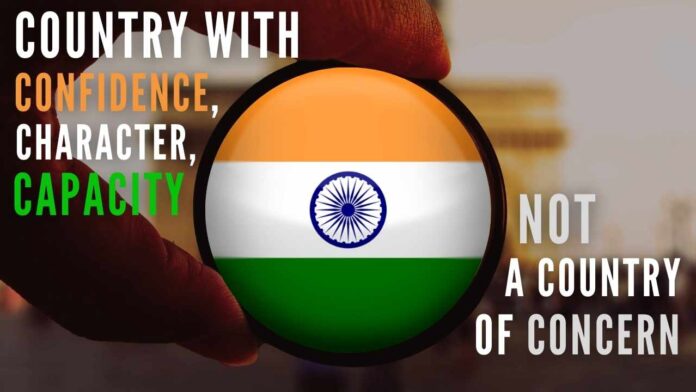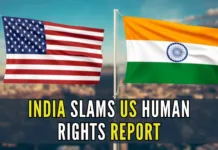
India deserves mutual respect from the United States and the rest of the world
In an annual ritual, the USCIRF (United States Commission on International Religious Freedom) once again recommended that India be declared a Country of Particular Concern (CPC)[1]. Recently, USCIRF alleged “repression” of critical voices, especially religious minorities. This drew harsh words from the Ministry of External Affairs citing the comments as “biased” and “inaccurate”[2]. The spokesperson went on to add that the comments reflect a “lack of severe understanding” of India,” by USCIRF which is so very accurate.
While Indians and friends of India were about to celebrate the 75th anniversary of independence, a group of four, unable to stomach the rising new India on the global stage, advocated for the CPC designation of India[3]. They misconstrued and misrepresented the facts, with many half-baked and unsubstantiated claims. It is not just the notorious New York Times and Washington Post thriving on publishing anti-India, anti-Hindu, and anti-Modi articles, a Minnesota newspaper, where I live, published a similar opinion article. The same newspaper did not publish my rebuttal.
The sad truth about the opinion is its educated non-Muslim authors, including one Hindu, who to the best of my knowledge, are not born in India and/ or frequently visited. Yet they have an opinion based on their selective and biased reading and hearing even in the age of the internet and social media. They also use blinders not to see India as a shining example of a “Country with Confidence, Character, and Capacity.” Let us discuss, why?
Anyone watching an upbeat Prime Minister Modi’s address in Delhi on August 15 will note his unparalleled confidence and resolute for a developed, stronger, and self-reliant India. In fact, Modi laid down the future vision for a “Developed India” by 2047 and challenged everyone, particularly, the youth to be the engine of economic growth and innovation. India’s undeterred and strong diplomatic confidence is evident from its successful balancing of delicate political relationships with the U.S. and Russia simultaneously in the wake of the Ukraine-Russia war. India’s Foreign Minister has made it amply clear on more than one occasion that India will carve its own path and policies in the best interest of its people.
India’s character is deeply rooted in its ancient civilization with rich history and heritage. India is secular not only constitutionally but secularism is embedded in the philosophy like Vasudhaiva Kutumbakam (The World is one Family). Despite many aggressors, the Arabs, Portuguese, Dutch, and British, India followed values like tolerance, forgiveness, non-violence, peace, and Satyamev Jayate (truth always wins) to name a few. In recorded history, India did not wage a war including in modern times; only defended her sovereignty when provoked.
India’s capacity includes her well-educated and ambitious youth. They are eager to change not only India but the world with their knowledge, innovation, industriousness, and entrepreneurship. A recent report shows that over 57,000 startups are launched to date with total capital raised of about $131 billion since 2014 and a combined evaluation of about $450 billion[4].
Additionally, India’s growth in the prestigious unicorn club has been remarkable since its first entry in 2011. The unicorn club includes companies valued at USD 1 billion or more. This year alone, 20 startups have entered the unicorn club in the first seven months reaching the number of unicorns to 106[5]. The projected growth of unicorns in India is 250 by 2025. The Make in India and newly initiated “Atmanirbhar” (self-reliant) are making India the envy of many developing and developed countries. One should also not overlook that Indian professionals are in high demand globally to meet the talent workforce needs everywhere.
The USCIRF recommended CPC designation for India for the third year in a row but the State Department did not do it in the preceding two years. I surmise it to be no different this year. India is a natural ally, a QUAD member, an increasingly important bilateral trade partner, and a strategic partner in defence, space, vaccine manufacturing, and other R&D areas of mutual importance. Today’s confident India is also the biggest hedge against expansionist China geopolitically.
The article in Minnesota alleges that two senior officials of India’s ruling BJP party made “insulting” and “derogatory” remarks against Islam and the Prophet Mohammad[3]. However, it conveniently ignored that both have been reprimanded for making insensitive but factual remarks. The article also missed what followed. For example, two gruesome beheadings of innocent Hindus by Muslim extremists in a matter of weeks. Numerous threats against the life of one of the accused officials, Nupur Sharma (NS), similar to Salman Rushdie who was recently stabbed in New York by an Iranian Muslim. The gruesome beheading of innocent Hindus in India by extremist Muslims is similar to the inhuman murder of George Floyd in Minneapolis by a White policeman with neck compression. The Minnesota authors should have condemned such violent acts irrespective of who lost life and where, totally inexcusable in a civilized society.
How irresponsible of the authors to allege that the Indian judiciary is headed down a treacherous path, not only against Muslims who have a long history in India but against ‘all Muslims[3].’ It is true that Hindus and Muslims have lived together in relative harmony in India even after the breakaway of Islamic Pakistan in 1947. When talking about the treacherous path, are they questioning the sanctity of India’s judiciary? Is the use of ‘all Muslims’ meant to create a further wedge between Hindus and Muslims? Both are farfetched.
Would they characterize the U.S. judiciary as heading on a treacherous path because of the recent reversal of abortion laws? It is plain wrong and insensitive to include all Muslims, Hindus, and Christians in any context because everyone is different. For example, would the non-Muslim authors justify stating that all-Muslim doctors are terrorists if a Pakistani doctor at Mayo Clinic pleaded guilty to pledging his allegiance to the Islamic State and carrying out lone wolf attacks in the U.S?[6]
Another misconstrued fact includes the demolition of only Muslim homes. On the contrary, both Muslims and Hindus have had their illegal properties ceased and/ or demolished only after due process. Relatively more Muslim homes were demolished because more of them acquired and/ or built properties unlawfully. The authors failed to mention numerous incidences of targeted and pre-mediated stone pelting by Muslims after the Friday prayers in many Indian cities. These weekly brutal occurrences were hurting police and officials and causing extensive property damage. The courts rightfully punished the accused when found guilty.
The question is also raised why Muslims are excluded from CAA which prompted the futile passage of a resolution against CAA by the Saint Paul city council. I surmise that imagining Muslims persecuted in an Islamic country would be insulting, insensitive, and presumptuous to an Islamic country. India’s CAA is similar to the Lautenberg law in the United States which allowed expedited processing only for Christians. Suffice it to say that India has legal provisions for anyone including the Muslims and Rohingyas to seek citizenship.
As big and diverse as India with 1.3 billion people of all faiths, the isolated incidences of religion-based and other conflicts are natural. India’s 80% Hindus are the most tolerant and accepting of others unless provoked. The ill-conceived assertion that “India as a nation has an agenda of radical Hindutva and Hinduism as the only true Indian way of life,” is far from the truth. India upholds her constitutional responsibilities of secularism and everyone is free to practice their religion as discussed below. There is no truth in suggesting that there is large-scale religious strife in India.
A 2021 Pew Research report notes that 80% of Indians are united in respecting other religions as they value their own. Based on a survey of nearly 30,000 people in all six major religious groups, the report overwhelmingly concludes that they are very free to practice their faiths, and most say that people of other faiths also are very free to practice their own religion.
Let it be the discretion of the readers which of the two reports – an independent Pew report or a highly politicized USCIRF- is more credible. The former is based on a face-to-face survey while the latter is a compilation of the self-selected incriminating incidences during the Covid with limited travel between India and the U.S.
India is a thriving, stable, and mature democracy. Her people and leaders have attained a very high degree of confidence and are capable of deciding their destiny. India’s iconic heritage, cultural diversity, and pluralism define its character. It is my conviction and belief that today’s India deserves mutual respect from the United States and the rest of the world. India must be understood and appreciated for what it stands for rather than a designation like CPC unless the last C stands for Confidence, Character, and Capacity of India in the global context.
Note:
1. Text in Blue points to additional data on the topic.
2. The views expressed here are those of the author and do not necessarily represent or reflect the views of PGurus.
Reference:
[1] USCIRF–RECOMMENDED FOR COUNTRIES OF PARTICULAR CONCERN (CPC) – USCIRF
[2] India slams USCIRF for ‘misrepresenting’ facts – Jul 2, 2022, ToI
[3] Ellen Kennedy, et al: Why the U.S. should designate India a ‘country of particular concern’ – Aug 11, 2022, Twin Cities
[4] The State Of Indian Startup Ecosystem Report, 2022 – Inc 42
[5] Here Are The 20 Indian Startups That Entered The Unicorn Club In 2022 – Aug 18, 2022, Inc 42
[6] Pakistani doctor who pledged his allegiance to Islamic State pleads guilty to terror charge in Minnesota – Aug 17, 2022, Fox News
PGurus is now on Telegram. Click here to join our channel and stay updated with all the latest news and views
For all the latest updates, download PGurus App.
- Education and election in Bharat: Race to the top - April 16, 2024
- Kejriwal: “An Insignificant Man” or a corrupt politician with impending prison term - March 24, 2024
- Bharat’s general elections and the Model Code of Conduct - March 22, 2024











Chandrachud back at his usual mischief..
.
SC asks Centre to seek reports from 8 states on alleged attacks on Christians
Observing that it needs to separate “grain from the chaff”, the Supreme Court on Thursday asked the ministry of home affairs to call for reports from Uttar Pradesh, Madhya Pradesh, Haryana, Karnataka, Odisha, Chhattisgarh, Bihar and Jharkhand on alleged attacks on members of the Christian community, rejecting remonstration by the Centre.
The top court said though it believes crime against an individual does not necessarily mean crime against society, but even if 10 per cent of the cases alleged in the PIL is true, then it needs to go to the bottom of the issue.
The Centre told the court it should not entertain the PIL based on “self-serving reports” as it could have wider ramifications.
“We need to separate grain from the chaff, even though we believe that an attack on individuals does not mean it is an attack on the community. We need to verify the claims of any such incident claimed in the public interest litigation,” a bench of Justices DY Chandrachud and Hima Kohli said.
Deprecating the court’s stand, the Centre contended 162 of the cases mentioned in the PIL have been found to be fake on verification at the ground level.
Responding to the contention, the bench said, “This is a PIL and we are starting with a presumption that what is being claimed may be true.
“We can have a verification exercise and start with at least 4-5 states and ask the ministry of home affairs to submit a report after collating the data on what action has been taken on such incidents of violence, status of FIRs and arrests made and whether any charge sheet has been filed in these cases or not.”
The court directed the chief secretaries of all the eight states to ensure these details are submitted to the MHA.
Solicitor General Tushar Mehta asserted majority of the alleged cases mentioned in the PIL were found to be false and based on “self-serving articles” published on a web portal upon verification.
Well articulated, fact based article. Should get posted in all the social media.
Sir, Kudos for a god article.
A lot of social media campaigns should be launched to educate the public in the US about this.